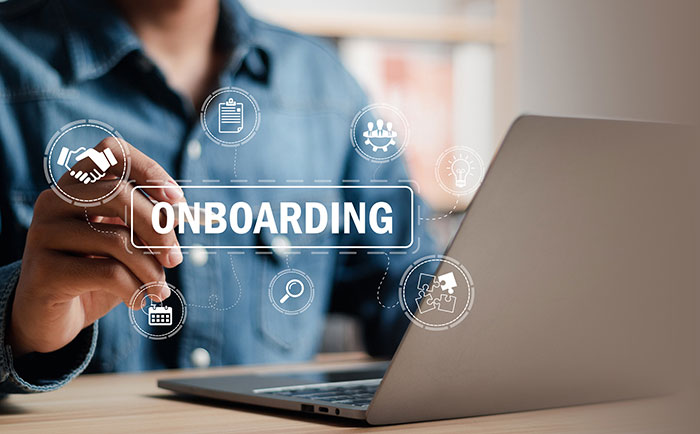Virtual Reality Onboarding: Revolutionizing Employee Integration

January 14, 2025
SEB Marketing Team
The onboarding process sets the tone for a new employee’s future journey within a company. Traditional onboarding methods—manual processes, lengthy presentations, and static training— can be overwhelming to new hires as there is so much information to absorb. Virtual Reality (VR) is a potential innovative solution, offering immersive, engaging, and tailored experiences that cater to modern workplace needs and making onboarding more exciting.
Why VR Onboarding?
Virtual Reality onboarding leverages immersive technology to simulate realistic workplace scenarios, providing an unparalleled level of engagement. By integrating VR into your onboarding process, HR professionals and business leaders can foster a stronger connection between new hires and organizational goals from day one. Here are some key benefits:
Standardization & Consistency: VR ensures that every new employee receives the same high-quality onboarding experience, regardless of their location or role. From compliance training to an introduction to company culture, VR guarantees consistent messaging, reducing discrepancies often seen in traditional onboarding processes.
Realistic Simulation: Through VR, new employees can experience life-like simulations of their job roles. Whether offering a virtual office tour, navigating complex machinery or responding to workplace scenarios, these hands-on experiences help employees build confidence and skills in a controlled environment, reducing the learning curve.
Time and Cost Efficiency: While VR technology requires an initial investment, it reduces long-term costs by minimizing the need for extensive in-person training and repetitive sessions. Additionally, new employees can complete modules at their own pace, saving time for both trainers and trainees.
Global Accessibility: For remote or globally distributed teams, VR onboarding eliminates geographical barriers. Employees in different locations can participate in the same immersive onboarding sessions, ensuring equity and inclusivity in the experience.
Improved Job Performance: Immersive training provided through VR allows employees to practice tasks repeatedly, enhancing their understanding and proficiency. VR offers opportunities for skills development such as customer service representatives rehearsing challenging scenarios or employees familiarizing themselves with new software and tools before real-world applications. This leads to faster skill acquisition and better preparedness for real-world challenges, resulting in improved job performance from the outset.
Challenges and Considerations
While the benefits of VR onboarding are compelling, organizations must also navigate certain challenges:
Cost of Implementation: Implementing VR technology requires an upfront investment in hardware, software, and content creation. Consider the costs against projected ROI and explore scalable solutions or partner with VR providers to help manage expenses.
Technical Expertise: Developing and maintaining VR programs requires expertise in both technology and instructional design which will require either collaboration with specialized vendors or upskilling internal teams.
User Accessibility: While VR is intuitive for many, it may present challenges for employees who are less tech-savvy or have specific physical or cognitive needs. Providing alternative onboarding options ensures inclusivity and accommodates diverse employee profiles.
Integration with Existing Systems: Currently, VR is not meant to replace any existing HR processes and technologies. It works best as a complementary onboarding option. Seamlessly integrating VR tools with learning management systems (LMS) or HR platforms makes a more streamlined experience.
How to Get Started
Define Clear Objectives: Identify which aspects of your onboarding process will benefit most from VR integration, such as skill development, role-specific training or company culture immersion.
Start Small: Pilot VR onboarding with a specific department or group to gather insights and measure effectiveness before introducing it to the entire organization.
Choose the Right Partner: Work with vendors experienced in VR solutions not only for actual onboarding and training but also to ensure alignment with your organization’s objectives and goals.
Plan for Maintenance: VR headsets and equipment require regular maintenance to ensure optimal performance and longevity. Not only do they need to be kept clean and sanitized, but they also require regular inspections for wear and tear, and other damage. Additionally, VR software needs to be updated regularly to improve functionality, fix bugs, and enhance security.
Provide Training: Ensure employees and trainers are comfortable with VR technology by offering initial training and ongoing support. This will help address potential technical issues and boost user confidence.
Monitor and Refine: Collect feedback from participants to continually improve the experience and maximize the effectiveness.
As workplace technology evolves, Virtual Reality onboarding offers an engaging and immersive experience for a more innovative, inclusive, and effective employee integration. HR professionals and business leaders who adopt VR onboarding now will not only enhance new hire engagement but also position their organizations as forward-thinking leaders in talent development. By embracing VR, your organization can create a memorable first impression that sets employees up for long-term success and satisfaction.
Post navigation
Related Posts

3 Keys to Sustainable Excellence of High-Performance Teams
You spent a considerable amount of capital and time hiring the best engineers, the most…

Your 5-Point Generative AI Policy Checklist for HR and Tech Leaders.
It’s official: Generative AI (GenAI) is no longer a futuristic concept—it’s a powerful productivity co-pilot…

The Psychological Safety Re-Check: Why Even Top Teams Need a Periodic Vulnerability Audit
You’ve built a rockstar team. They hit their numbers and they crush their goals. Congratulations!…
